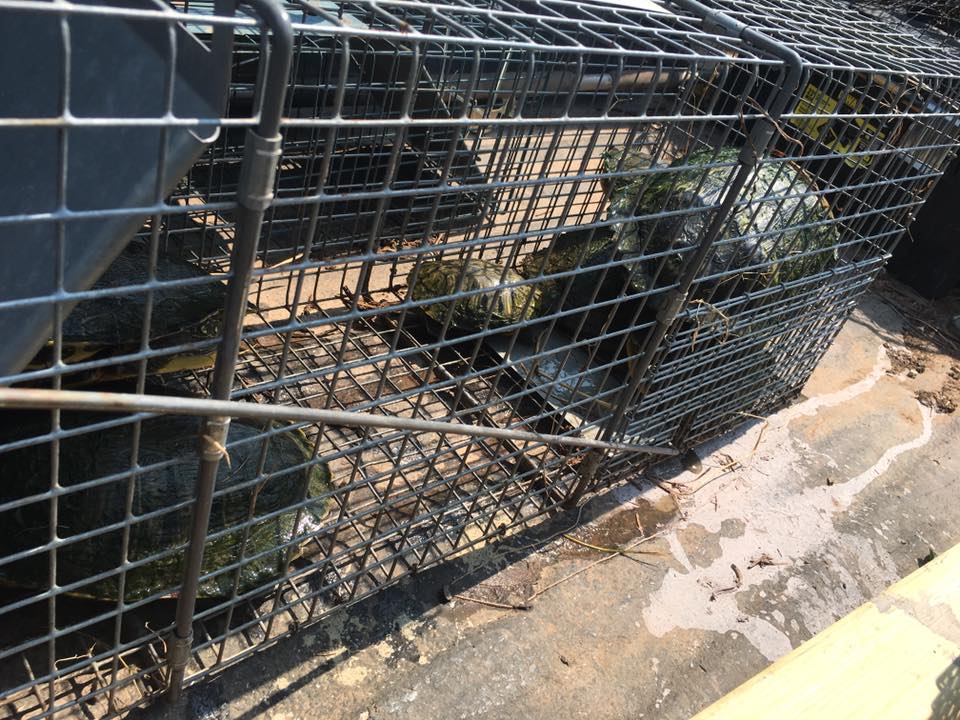Civilians should not attempt to handle turtles, especially the more aggressive species, as this leads to injury or disease. Contacting trained wildlife specialists who have the knowledge, training, and tools to successfully eradicate turtles is the most effective way to eliminate populations of the pest. Meneely Wildlife Control can trap and humanely relocate turtles for property owners.
Turtle Habitat:
Turtles inhabit grasslands, marshes, and woodlands they prefer habitats near bodies of water like ponds, rivers, or lakes. Snapping turtles prefer slow moving or brackish water that have muddy bottoms and plenty of plant cover. The reptiles spend a lot of time in the water but climb out to bask on banks, logs, or rocks on sunny days.
Turtle Control:
Most turtles are not good climbers, so erecting fences and implementing other methods of exclusion usually effectively controls populations. Trapping can also work, though most devices are heavily involved and take time, money, and training.
Biology:
When a pond becomes overpopulated with turtles often the only remedy available is turtle removal or turtle trapping. Semi-aquatic reptiles, turtles are shelled animals that can be found across the United States. They have existed as a species since prehistoric times, and some turtles have been known to live for over 100 years. Though they are notoriously slow-moving, turtles never let their speed keep them from becoming nuisance pests in some areas of the country.
All turtles possess a shell comprised of bone covered in keratin plates, a substance similar to human fingernails. Turtle shells are permanently attached to the back and ribs of the reptile, which means turtles cannot leave their shells. They come in various shades of green, brown, and gray, which helps them blend into their surroundings. Most turtles grow less than a foot long, though the common adult snapping turtle can be as long as two feet and weigh in excess of 35 pounds. Turtle feet have claws and their mouths are toothless and function similarly to bird beaks. Ocean-dwelling turtles have flippers instead of feet.
Do turtles enter homes or yards?
The shelled reptile has been known to enter yards and gardens in search of food. Turtles are omnivorous animals that eat fish, snails, and insects in addition to grasses, flowers, fruits, and other vegetation. Their diets often bring them into contact with people and earn them their status as nuisance pests. Overpopulation in ponds on farms or in parks is often a concern.
Do turtles harm people or property?
Snapping turtles can be seriously dangerous to human beings as they have notoriously strong bites. Alligator snapping turtles, for example, can grow to massive sizes and have been known to behave aggressively. Though they are not as immediately dangerous as snapping species, common turtles will bite and scratch when handled and may carry salmonella. Additionally, turtles can damage gardens and fisheries when populations grow large enough.
If you need turtles removed in Wichita, KS and would like a Meneely Wildlife Control technician to provide expert wildlife removal services for you, please contact Meneely Wildlife Control by calling
(580) 761-6526 in Wichita, Andover, Rose Hill, Derby, Haysville, Schulte, Goddard, Clearwater, Mulvane, Udall, Wellington, Oxford, El Dorado and other Kansas locations. We solve turtle problems in lawns & gardens by trapping and removing turtles.
When you need snapping turtles removed in Ponca City OK, Newkirk, Blackwell, Bartlesville, Stillwater, Enid, Pond Creek, Deer Creek, Lamont, Medford, Kaw City, Shidler, Fairfax and all other Oklahoma locations, pick up the phone and call Meneely Wildlife Control at
580-761-6526.
